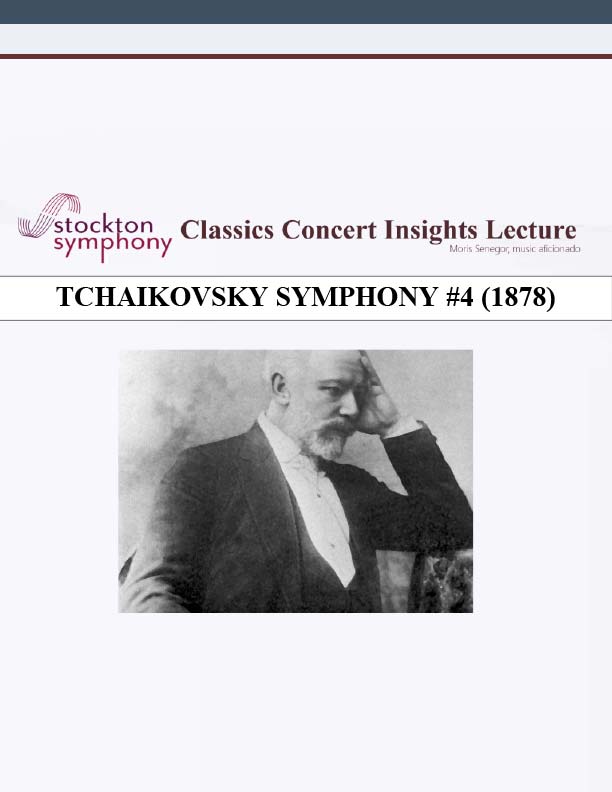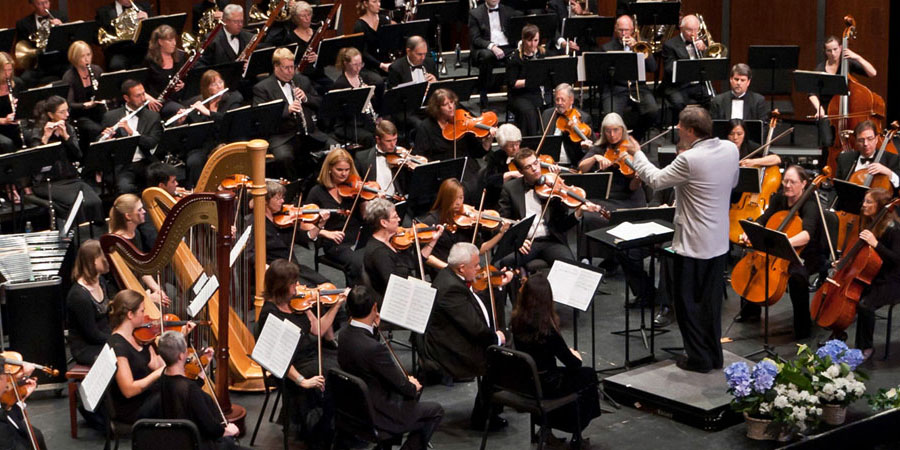
REMINDER ON MUSICAL HISTORY:
- Renaissance & Middle Ages.
- Baroque (1600-1750) – Bach, Handel, Vivaldi.
- Classical (1750-1827) – Haydn, Mozart, Schubert, early Beethoven.
- Romantic (1827-1900) – Late Beethoven, Brahms, Berlioz, Schumann, TCHAIKOVSKY, Mahler, Dvorak.
- 20th Century – Stravinsky, Copland, Bartok.
HISTORY OF RUSSIAN CONCERT MUSIC:
- Peter the Great (1682-1725) builds St. Petersburg: 1703.
- Emergence of Russian music: Mikhail Glinka (1804-57).
- Post-Glinka, “the Five”:
- Mily Balakirev(1837-1910) Army engineer
- Caesar Cui (1835-1918) Military engineer
- Modest Mussorgsky (1839-81) Army, Civil Servant
- Nicolai Rimsky-Korsakov (1844-87) Aristocrat, Navy
- Alexander Borodin (1833-87) Doctor
- The Conservatory Tradition: Anton Rubinstein (1829-1894) founds St. Petersburg Conservatory :1862;Nicolai Rubinstein (1835-1881) founds Moscow Conservatory: 1864.
- Peter Ilyich Tchaikovsky (1840-1893) graduates St. Petersburg Conservatory: 1865.
“THE FIVE”:
- None were trained professional musicians; all self- taught.
- Their music is essentially thematic, with little development.
- Their music features nationalistic folk melodies.
- Their music is rhythmically and expressively powerful, and sounds less sophisticated to ears accustomed to German/Italian music.
TCHAIKOVSKY BIOGRAPHY (1840-1893):
- Born 5/7/1840 in Votkinsk to middle-class gentry family.
- 1852-59: Enrolled in St. Petersburg School of Jurisprudence.
- 1862- 65: St. Petersburg Conservatory.
- 1866: Joined faculty at Moscow Conservatory.
- 1868: First Symphony.
- 1869: Romeo & Juliet.
- 1876: Starts composing Symphony #4.
- 1877: Disastrous marriage to Antonina Milyukova.
- 1877: Thirteen year patronage of Nadejda von Meck begins; quits Conservatory.
- 1878: Premiere of Symphony #4.
- 1880’s: Tchaikovsky acquires international reputation.
- 1893: Sixth Symphony & death.
HISTORY OF SYMPHONY #4:
- Tchaikovsky began composing in the winter of 1876-77.
- It was nearly complete by May 1877.
- Composition was interrupted in July 1877 by his marriage to Antonina Miliukova, a former student.
- The union lasted 2.5 months, Tchaikovsky escaped abroad for a year.
- Tchaikovsky returned to the Symphony in December 1877 and rapidly completed it by January 1878.
- He dedicated the work to Nadezhda von Meck, “Dedicated to my best friend”.
- Premiere in Moscow, by Nicolai Rubinstein, 22 February 1878.
DEFINITIONS:
- CATHARSIS SYMPHONY: Music that starts exploring the dark side of emotional spectrum and ends in the bright side. Examples Beethoven #5, Brahms #1.
- PROGRAM MUSIC: Music that depicts extra-musical material. Examples: Beethoven Symphony #6, Berlioz Symphony Fantastique.
- Tchaikovsky provided a detailed program to Nadezhda von Meck. Excerpts will be provided below. Note that the composer’s thoughts represent an after the fact interpretation of what he had created. They should not be used as a strict guide on how to listen to this work.
“In essence my symphony imitates Beethoven’s Fifth.” Tchaikovsky, (in a letter to his pupil Taneyev).
SYMPHONY #4:
- FIRST MOVEMENT: Andante sostenuto – Moderate con anima (in movimento di Valse) (F minor)
- SECOND MOVEMENT: Andantino in modo di canzone (B flat minor)
- THIRD MOVEMENT: Scherzo (Pizzicato ostinado) – Allegro (F major)
- FOURTH MOVEMENT: Finale: Allegro con fuoco (F major)
FIRST MOVEMENT: SONATA FORM
INTRODUCTION:
- “The introduction is the seed of the whole symphony….This is fate.” Tchaikovsky.
- The “Fate Theme”: (F minor) A series horn fanfares. Tchaikovsky harkens back to Beethoven’s 5th in his use of the word “fate”.
- The horn-calls fade into loud, then quiet 4-note motives, then quieter 2-note motives, each with distinct rhythms. Pause.
- NOTE: This horn-call will mark each transition between sections, and it will return verbatim in the Fourth Movement.
EXPOSITION:
Theme I Complex:
- A lengthy melody (F minor), dark and agitated in mood.
- “The cheerless and hopeless feeling grows yet stronger and more burning.” Tchaikovsky.
- This theme is in 9/8 meter, unusual for symphonic movements; it creates a “waltz within a waltz” feeling since there are three groups of three in each bar.
- Theme I repeated twice and subsequently subjected to development.
- This development is almost as long as the “real” development section, and features Theme I motives, some with unique “rhythmic signatures” that will reappear in the remainder of the symphony.
- The Theme I complex ends with a forte orchestral repetition of theme, accompanied with lightning-like loud, syncopated chords.
- This entire section maintains an agitated, stormy mood.
Transitional Theme:
- A much calmer, rustic tune (A-flat major) derived from Theme I, briefly appears in the wind instruments.
- This sounds different because of the stable harmony, and calm context.
- Music fades in an introductory gesture and pauses.
Theme II Complex:
- A sweet triple meter dance tune (B major) in clarinet, accompanied by winds, and later by strings. This is Tchaikovsky as we know him best. It could be any of his ballet music.
- “O joy! There appears…, a sweet and gentle day-dream.” Tchaikovsky.
- This tune is made of a series of two-note ideas that formed the basis of Theme I.
- Theme II repeated in several variations, including some which feature a Theme I motive in accompaniment. It maintains a dance-like character in all these variations.
- “How good this is! How distant now sounds the obsessive first theme of the allegro….There she is – happiness!” Tchaikovsky.
Closing Music:
- Theme I motives, with a characteristic rhythm, steal away the calm mood, plunging the music into agitation, with a closing theme initially in strings, then loud in horns.
- A fast syncopated passage provides a codetta; the incessant rhythm here harkens to Beethoven’s Symphony #7.
- Fate Theme reappears, marking transition from Exposition to Development.
DEVELOPMENT:
- Section starts with Theme I motives quietly sequenced, in a passage that David Brown characterizes as “obsessive preoccupation with the rhythmic world of the first subject”, again harkening back to the same section in Beethoven’s Symphony #7.
- Theme I repeated, but soon broken down into its motives.
- Another attempt a repeating Theme I, music again breaks down into fragments.
- Another Theme I motive sequenced in an obstinate, crescendo passage, leading into Fate Motive fanfares on horns.
- Music now loud and agitated with theme I fragments alternating, with “Fate” fanfares “violently intruding”, and “savagely hammering at …the main material.” (David Brown)
- “This is one of the most powerful developments in the repertoire.” (Peter Jaffe).
- This development section is rather brief, compared to the overall scale of the movement. Tchaikovsky does not need to elaborate this section since he has mined this musical material earlier in the Exposition..
RECAPITULATION:
- Theme I in D minor (“wrong” key) barely audible under a sound-wall of ff trombones, makes an abbreviated appearance. This is easy to miss, and can easily be mistaken as a continuation of development.
- The loud and agitated mood fades away into calm; an introductory gesture.
- Theme II (D minor) reappears and is stated in its various versions as in Exposition.
- Theme II is easy to recognize not only by the lovely tune, but also because it is the only calm music in this movement. Theme II takes up the majority of the recap.
- Overall Tchaikovsky creates an impression that the music recapped directly to Theme II.
- Truncated Closing Section, now familiar from the Exposition.
- Fate Theme returns, marking transition to Coda.
CODA:
- Starts with a quiet chorale in the winds, accompanied by agitated Theme I motives beneath in accompaniment.
- A rollicking version of the theme takes over, accelerating in tempo, and crescendo.
- A ff return of Theme I, brief and truncated. Finally in F minor, the home key. Ushers a speedy end of the movement with concluding chords.
- “No! These were daydreams, and fate wakes you from them…Thus all life is an unbroken alternation of hard reality…No Heaven exists…” (Tchaikovsky).
NOTES:
- This movement takes the Classical Era Sonata Form as a model, but expresses it with a distinctly late 19th century aesthetic, extensively altered and elaborated.
- Sub-sections are disproportionate, the Exposition taking up nearly half the movement.
- Themes are no longer simple tunes but complex passages.
- There are, in effect two development sections.
- The music does not recapitulate into the first theme, or to the home key.
- The Coda assumes a novel role: instead of rounding out events that have already run their course, it is now a new and crucial section in the narrative.
- Theme I experiences, in effect a delayed recap at the very end of the coda. This changes the expected narrative, delaying the focal point of the drama from the middle of the movement to the end.
- “Having emphatically set up F minor as the center of gravity in the introduction…he declines to return to that key until this long movement is nine-tenths over. That moment… is more powerful for the extreme delay.” (Michael Steinberg).
- The movement is Beethovenian in its varied use of rhythm to create drama, and in motivic integrity (everything is derived from simple motives outlined in the introductory fanfare).
- In this movement Tchaikovsky displays his Conservatory acquired, and by now well- honed “Germanic” compositional skills.
SECOND MOVEMENT: A-B-A, TERNARY FORM
A:
- Theme announced by a solo oboe with pizzicato string accompaniment. It is a “melancholy song introduced by …. the most melancholic of wind instruments” (Michael Steinberg).
- Repeated in cellos.
- Countermelody in strings. It is extended, and it rises briefly before calming down.
- Theme repeated in low strings with differing accompaniment, followed by countermelody.
B:
- Transitional music introduces motivic fragments of what is to come.
- A new theme in low winds. A rustic melody. Repeated in different instrument groups.
- Music climaxes in loud orchestral restatement of this theme.
- Music dies down into motivic fragments. Transition.
A:
- Theme returns in high strings with a birdcall like accompaniment in winds, and persistent pizzicato base in low strings.
- Countermelody returns unaltered.
- Music brakes down into fragments of the theme in a quiet, hesitant passage which leads to a variation of the theme in strings. Music drops.
- Theme reappears in bassoon in yet another variation.
- A codetta with theme fragments stated in various wind instruments.
- Music dies down in tempo and dynamics, and all that’s left is the pizzicato base, which ends the movement peacefully.
NOTES:
- This movement is a calm and lyrical respite from all the “sturm und drang” of the first movement.
- Tchaikovsky explains it as “another phase of depression”, weary reminiscences of good and bad memories from past life.
- It is exclusively thematic music, of the kind favored by “The Five”.
THIRD MOVEMENT: A-B-A TERNARY FORM
A: SCHERZO
- Strings play a playful pizzicato tune, which is extended.
- Tune repeated.
B: TRIO
- A loud sustained oboe note announces this section. “The pizzicato theme (is) suddenly annexed by the woodwind.” (Michael Steinberg)
- A rustic dance tune is played by the winds.
- Repeated by piccolo.
- A march-like tune appears in the brass and alternates with the dance tune.
- Transitional music.
A: SCHERZO DE CAPO
- The pizzicato string tune returns and is repeated.
- Codetta features Scherzo tune juxtaposed with Trio tunes, including the little march.
- Music ends abruptly.
NOTE:
- Tchaikovsky’s choice of an all pizzicato Scherzo was original, and became a hit with audiences.
- “The movement deconstructs the orchestra into its large principal groups: the strings, winds and brass.” (Peter Jaffe).
- “Once the symphony was in circulation, (Tchaikovsky) was annoyed because it was always the “cute” scherzo that made the biggest hit.” Michael Steinberg.
- “The Third movement expresses no definite feeling. It is made up …of elusive images which rush past the imagination when you have drunk a little wine and experience the first stage of intoxication.” Tchaikovsky.
- He then makes references to capricious arabesques, drunken peasants, street songs, a distant military procession, as disjointed images.
FOURTH MOVEMENT: RONDO
- Theme I: (F major) After an introduction which starts boisterously, and subsequently foreshadows motives of Theme II, a loud, fast and cheerful melody breaks out. It sounds like a celebratory dance, with lots of cymbal clashes. Near the end music recalls motives of Theme I from the First Movement. “If within yourself you find no reason for joy, look at others…A picture of festive merriment of the people.”(Tchaikovsky).
- Note: the introductory melody is the scherzo theme, rhythmically altered and re-orchestrated.
- Theme II: (B flat minor) A Russian folk song, “Vo polye beryozinka stolaya” (“In the fields there stood a birch”). This is a version of the song, rhythmically altered, as it appeared in a Balakirev overture. The tune is repeated in several variations.
- After a truncated introduction, Theme I returns verbatim.
- Theme II returns in a slow, quiet variations. The variations gradually become louder and more agitated in brass instruments.
- Suddenly and unexpectedly, the Fate Theme from the First movement intrudes. It causes the music to become fragmentary and quiet. The music dies in a passage reminiscent of Beethoven’s Fifth Symphony, First Movement.
- Theme I to the rescue! It approaches from a distance with a tympani roll, like cavalry, and rises in tempo and dynamics. Rondo comes back to life.
- Fast codetta, boisterous and energetic, recalls Theme II in horns, and speeds into a loud conclusion.
- “Hardly have you managed to forget yourself….,than irrepressible fate again appears and reminds you of yourself. But others don’t care about you. ….O, how they are enjoying themselves.” (Tchaikovsky).
NOTE:
- This movement is a simple theme and variations construct with two themes alternating; “the simplest of simple rondos” (David Brown).
- The largely thematic nature of the movement and its use of a Russian folk melody, again appeals to the aesthetic of “The Five”.
- The movement is too “simple” for the late 19th century, fourth movement rondos being more common a century earlier, in the era of Mozart and Haydn. It thus invites criticism.
- “It is a rather sad end to a symphony which had begun so magnificently” (David Brown).
- “I think that David Brown is unnecessarily vicious here – the romping last movement is always an undeniable crowd pleaser.” (Peter Jaffe).
“To the end of his life Tchaikovsky thought himself clumsy about form. Let us say that he could be painfully academic and astoundingly adventurous, and that he could miscarry at both extremes.” (Michael Steinberg).
“My symphony is definitely the best work I have written so far.” Tchaikovsky, in a letter to his brother Modest, Fall 1877.
“Composers should not be penalized for writing accessible works if the compositions also show much ingenuity – and I personally think Tchaikovsky does just that!” (Peter Jaffe).
“The Fourth Symphony is a true piece of emotional autobiography.” David Brown.
Tchaikovsky’s Fourth Symphony is an amalgam of Beethoven inspired “Germanic” craftsmanship, and a Russian nationalistic aesthetic that was pervasive in its time. It has survived in the repertoire as a frequently performed work because of the originality of the former, and the beauty of the latter.


